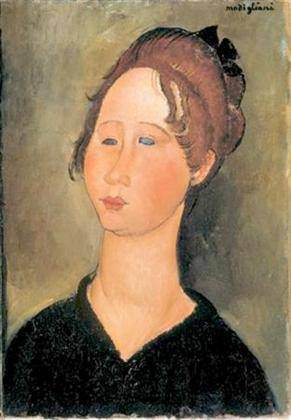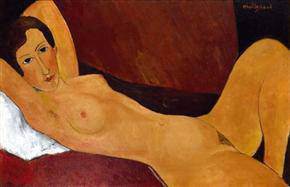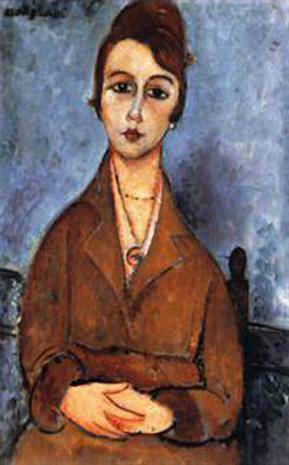
Amedeo Modigliani
La Bourguignonne
1918
Private collection

Amedeo Modigliani
Reclining Nude (Céline Howard)
1918
Private collection, Geneva

Amedeo Modigliani
Young Lolotte
1918
Private collection
Amedeo Modigliani at the Art and Exhibition Hall, Bonn
The exhibition will attempt to reveal the great strength of the paintings of Modigliani, which only at firstglance seem to be very much alike. It wants to demonstrate how the artist with the formal unity of hiscreativity, often connected with the red file of melancholy, reached an individuality of representation,which one can not resist. Originally oriented at dominant art currents of his time he very soon finds hisown style and sticks faithfully to the object known to him and pays it affectionate respect. All his worksdocument the restless manner of life of an artist full of relish, who in great sadness is fully aware of hisvulnerability and his mortality from his childhood on and who needs the euphoria of the intoxication, inorder to live and work.
April 17th until August 30th, 2009
]]>
The Italian Amedeo Modigliani (1884-1920) was painter, draughtsman and sculptor. His life workcomprises above all paintings (approximately 420) and drawings (approximately 1000). From 1909 to1913 he has also devoted himself to sculpture and left approximately 25 pieces.
His most important subject are portraits and nudes. He elaborates the individuality of depicted persons andmaintains at the same time his formal, painterly distinctiveness. Apart from that there are very few purelandscape paintings. From the view point of an art historian one is tempted to qualify them as an earlierworks, but in Modigliani’s career it stands for the quietness after a period of exhaustion. Not to beoverlooked in Modigliani’s paintings is their relationship to the language of the styles of renaissance andmannerism. He combines expressionist, cubist and symbolistic elements but as well takes up figures of theAfrican sculpture, popular at his time, which fascinated him because of their idolatry. He can not beclassified as belonging clearly to any of the contemporary styles like cubism or fauvism.
Modigliani spent his youth in Italy, where he studied the art of antiquity and of the renaissance before hemoved to Paris in 1906, already aware of the works of the impressionists and the symbolists.He moved into a studio on Montmartre, later on Montparnasse and was permanent part of the bohemianartist scene there. German painter Ludwig Meidner was among his first friends in the Parisian years beforethe first World War.
1907 was a decisive year in his artistic career, because he became acquainted with the young doctor PaulAlexandre, who from that time on supported him with purchases and contacts.The study of the finely coined cubistic works of Cézanne seems to have become a model for him and tohave given him the artistic freedom to use deformation, extension into overlength and idealisation asstylistic devices for a yet individualistic expression. Also Picasso’s pre-cubist works of the pink period areimportant bases for the figure in his painterly effort.
In the beginning of 1917 Modigliani got to know the 19 year old art student Jeanne Hébuterne and it cansurely be said that the most quiet and devoted portraits were created in those years. Modigliani and she leftParis together with the Zborowskis and Modigliani’s friend Chaim Soutine, when in 1918 an invasion ofGerman troops threatened and went to live on the French coast of the Mediterranean. Little is known aboutthe year in southern France, because there are hardly any written documents. It is however certain, that inNovember 1918 Jeanne Hébuterne gave birth to a daughter of the same name in Nice.
In the spring of 1919 Modigliani returned with Jeanne Hébuterne to Paris, where he got engaged with herover the summer and where they expected their second child. He participated in the “Salon d’Automne”and for the first time his works were through Zborowski shown outside of Paris in England. Even if he stilllived on the edge of financial existence and survived and kept working only with the help of friends andsponsors, this year seems to take a positive trend for him.
All the more bitter was the blow when at the end of the year he got ill of tuberculosis and died on January24th, 1920. Only one day later Jeanne Hébuterne committed suicide by throwing herself out of the windowand thereby killed her unborn child as well. Modigliani was buried on the cemetery of Père Lachaise withgreat public sympathy and Jeanne Hébuterne was later buried at his side, after her family had given uptheir resistance.
Follow us on:

